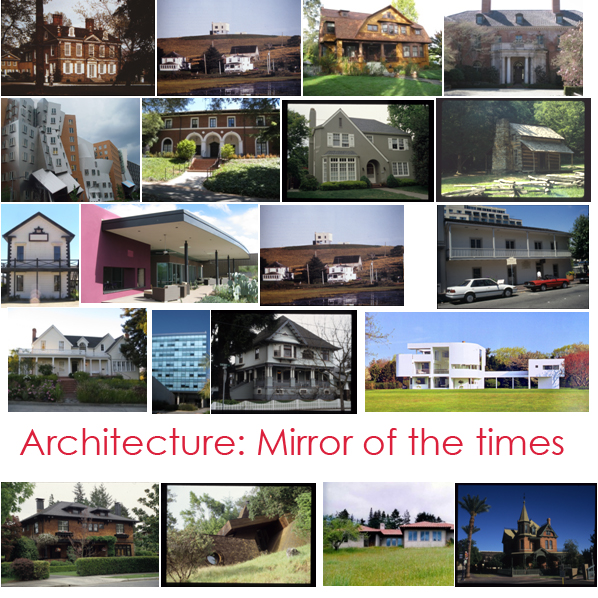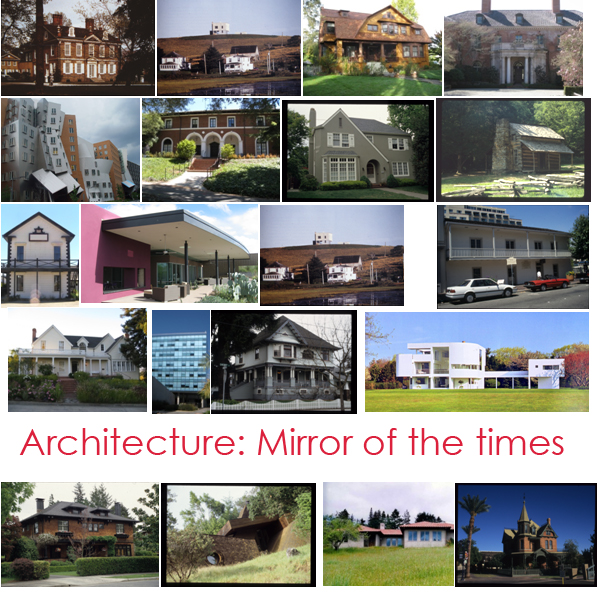Mark Parry donned his historic architectural bike helmet to guide one of three segments of the Redwood Empire AIA 2013 Bike Tour of Santa Rosa. The tour included the 1924 Proctor Terrace and the 1870 McDonald Additions to the city of Santa Rosa. Artisan Architecture was a sponsor of the event.
The McDonald Addition was developed by Mark McDonald in 1877. McDonald bought a seat in the San Francisco Stock Exchange after a time as an engineer in the mines about the Virginia City region. He had also become friends with Leland Stanford, Mark Hopkins, Charles Crocker and Collis P. Huntingon.- known as “the Big four” rail road barons all on the board of the Central Pacific Railroad. McDonald brought the Southern Pacific into Santa Rosa and had a terminal and warehouses on the edge of his 160 acre property on the east side of North Street. Now the Beacon Storage yards. The bike tour ended at his McDonald mansion known as “Mableton” recently rehabilitated by Rynerson Obrien Architecure, Inc of Berkeley. You can see more information on the McDonald history and this work at www.rynersonobrien.com/mcdonald/index.html
Proctor Terrace was the 1924 addition to Santa Rosa by Walter Proctor. After a train accident Mr. Proctor became a successful contractor and developer having built many bridges and office buildings. He arrived in Santa Rosa in the 1890’s from Wisconsin. His magnificent French Electric home is the center piece of the Proctor Terrace development that he created from Brayden lane west to St. Helena avenue. He received copies of plans from his friend Jack Benny who built a similar home in Bell Air.
The district has an eclectic mix of post WWI homes, mostly in the Provincial, Mediterranean,Craftsmen or Colonial styles. Notably these homes where inspired by the French and English country side. WWII “doe-boy’s” returned with a desire for European country architecture. This trend put an end to the home grown Craftsman and Art’s and crafts movement of the day. Once again America imported it’s style just as it’s home grown aesthetic matured. This also at the cost of the distinctive First Bay Region Tradition best exemplified by the work of Petaluma Architect Brainard Jones well represented at 718 McDonald Avenue.
The house at 1313 St. Helene built in 1937 was featured as an example of this ongoing trend of the colonial- aztion of american architecture. The home was built by Dr. Bowles who served in Flanders in WWI. and made a pen and ink drawing of the home he had appreciated. From that drawing Bob Whiting a prominent builder drew up a set of plans and built the house.




About The Author: Mark
Wm "Mark" Parry is an Artisan Architect, Poet and Educator, living in Northern California's abundant beauty and strange contradictions. He founded IdeaStudios.com in 1988 as architectural and interior design practice in the heart of Sonoma County. ArtisanArchitecture.com has advanced his interests in artisan architecture, historic and architectural education and preservation since 2002. On worksofwords.live he has shared his poems, musing's, inspired thoughts and photography since 2012. These his personal reflections on life, truth and reality. All operate under the umbrella of William Mark Parry Architect P.C. A Professional Corporation registered in California on 5.15.2000.
More posts by mark